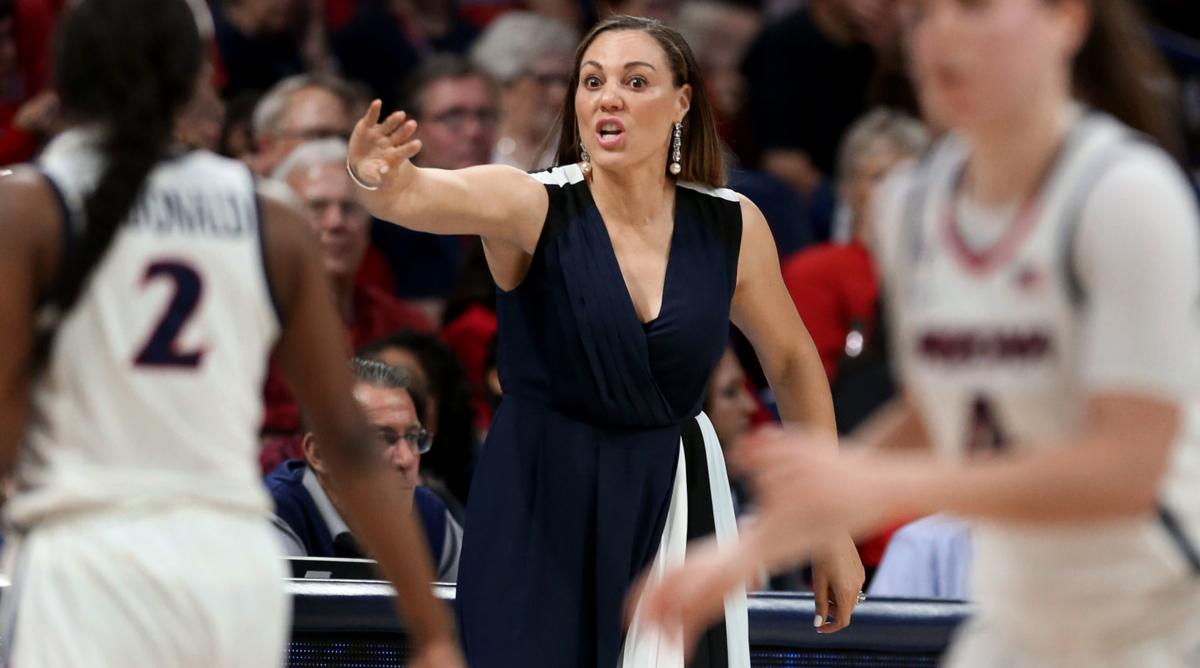One thing Northwestern coach Joe McKeown did not do before leaving McKale Center over the weekend was bow down and say, “Oh, Lord, circle the wagons, this is it.”
Maybe 10 years ago, and especially 20 years ago, any coach playing before a capacity crowd of 14,466 women’s basketball fans would’ve stepped back in awe.
Instead, McKeown accurately said Northwestern had recently played in settings just as formidable as the one at McKale Center.
Northwestern played before 12,057 fans on Senior Day at Iowa, when the nation’s No. 1 scorer, Megan Gustafson, was celebrated. Northwestern played before 10,308 on a Big Ten road trip to Maryland and Minnesota, and drew 5,799 at Northwestern’s new, $110-million Welsh-Ryan Arena, which he called “as good as any in the nation.”
Every variable of women’s college hoops – from on-court skill to finances, from facilities to coaching — is better than it has ever been, by far.
Tucson, which discovered women’s basketball the last few weeks, is actually late to the party.
Even Arizona’s captivating point guard, Aari McDonald, rightly said that her team’s road trip to Oregon State and Oregon — which drew 12,123 fans — was every bit as impressive as the rousing WNIT audiences at McKale.
So what happens next? How does Arizona make an upward move in the Pac-12, perhaps the NCAA’s most difficult women’s basketball league? How does it improve on winning the WNIT and double or triple this year’s regular season average of 2,200 fans per game?
It must re-work coach Adia Barnes’ contract before a WNBA team or a certifiable Top 25 program attempts to steal Barnes from her alma mater and make her the centerpiece of their operation.
Barnes is a keeper and then some. She’s got the “it” factor.
She is also the lowest-paid head coach in Pac-12 women’s hoops.
None of that is the fault of Arizona athletic director Dave Heeke. But it is on him to make UA women’s basketball a priority, which he said he plans to do.
A year ago, Washington State hired Kamie Ethridge as its women’s basketball coach, and agreed to pay her $400,000 a year through 2024. Yes, Washington State.
Barnes is paid a base salary of $235,000 per year.
How good or bad is that? Oregon just re-signed Kelly Graves to a six-year, $4.2 million contract. Cal’s Lindsey Gottlieb is paid $637,000 a year. Long-established Arizona State coach Charli Turner Thorne will be paid $440,000 annually through 2021. Even Utah signed coach Lynne Roberts to a six-year, $1.75 million contract.
The market for women’s basketball coaches has multiplied so emphatically that Mississippi State pays Vic Shaefer $1.6 million a year. Former Arizona basketball player Brenda Frese, who coached Maryland to the 2006 NCAA championship, is the third highest paid state employee in Maryland, at $1.2 million per year.
Heeke has been proactive in locking up the UA’s accomplished nonrevenue sport coaches. In the summer of 2017, he reworked the contracts of baseball coach Jay Johnson and softball coach Mike Candrea, deals that will pay roughly $500,000 per year through 2022.
Some of this doesn’t make fiscal sense, but college athletics last based coaching salaries on fiscal sense 25 years ago.

Arizona forward Dominique McBryde listens to the crowd sing Queen’s ‘We Are the Champions’ while climbing the ladder to the net following the Wildcats’ win against Northwestern in the championship game of the WNIT at McKale Center on April 6, 2019.
According to figures for the fiscal year 2017-18 released by the U.S. Department of Education, the women’s basketball programs at the Pac-12’s 10 public universities produced the following revenues:
Oregon State: $3.79 million
Oregon: $1.25 million
Washington: $1 million
UCLA: $944,962
Arizona State: $890,343
Then came the bottom feeders; Arizona was eighth out of the 10 with revenues of $656,784. None of the 10 Pac-12 women’s basketball teams operated in the black.
By comparison, Arizona’s men’s basketball program had revenues of $22.8 million, more than double any other Pac-12 school. That’s why it has been easy to justify Barnes’ current salary, which is a minimum of $40,000 less than every assistant coach on Sean Miller’s staff.
But that all changed the last few weeks when Arizona drew 45,622 at McKale Center and, with all five starters returning in 2019-20, positioned itself to climb near the top of Pac-12 attendance, led this season by Oregon’s 7,148 and Oregon State’s 5,438. If nothing else, Arizona should move past ASU’s average attendance of 3,062 fans per game and become No. 3 in the league.
The Wildcats are now authentic challengers for an NCAA Tournament berth, and not just an on-the-bubble team.
Winning the WNIT isn’t a national-scale event. ESPN doesn’t pay attention or send a film crew. But it turns heads within the women’s basketball industry.
When South Dakota won the 2016 WNIT, Nebraska stepped in and hired South Dakota coach Amy Williams, and now pays her $626,000 a year. When UTEP reached the finals of the 2014 WNIT, Wichita State noticed and soon hired UTEP coach Keitha Adams, paying her $315,000 a year, far more than Adia Barnes was paid this season at Arizona.
Barnes has not only put Arizona on the map, she’s on her way to making it a destination. As with everything else in college sports, the bill has come due.






